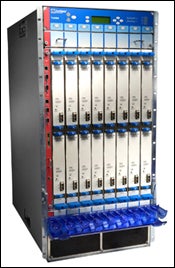In a world where there is a never-ending demand to serve as much bandwidth
as possible, carriers are always looking to grow their capacity. On the flip
side, space and power are always at a premium, which can sometimes conflict
with the need for more bandwidth.
Juniper Networks may have the answer with its new T1600
router, which can pump out a staggering 3.2Tbps (Terabits per second) of
throughput in a single standard 7-foot rack or 1.6Tbps in a half rack. With
all that power, Juniper claims that the T1600 consumes 30 percent less
cooling and power than competitive platforms.
 |
The T1600 Router Source: Juniper |
“There is a major upgrade going on in service providers upgrading their core
networks,” Chris Komatas, director of service provider marketing at Juniper,
told internetnews.com.
“The next-generation core network is all about
having the agility to support any service. T1600 is delivering No. 1 in
scale, No. 1 in service control and No. 1 in efficiency. All the
metrics that are important for a service provider.”
The keys to the performance throughput on the Juniper T1600 are the 100Gbps-capable slots that can support all the major connectivity options that
carriers may have. Among them is support for OC-768 (40 Gbps), OC-192 (10Gbps) and 10GbE (10 Gigabit Ethernet).
“A whole lot of legacy routers can’t handle next-gen traffic because they
only handle a maximum of 10Gbps per slot,” Alan Sardella, product
marketing manager at Juniper, told internetnews.com.
Juniper has also improved the performance of its packet processing in the T1600
with dual 50Gbps ASICs
control. Sardella noted that Juniper puts a chunky amount of its research
and development dollars into packet-processing technologies which is
reflected in the T1600.
Beyond just the physical silicon and interface connectivity, Juniper’s T1600
at its core is powered by the JUNOS operating systems which is a carrier
grade router operating system. Sardella boasted that Juniper has had 38
consecutive releases of JUNOS on a regular three-month interval. It’s a
process of continuous improvement driven by customer feedback, and the
demands of carriers that must have always-on capabilities.
In the network core of carrier infrastructure where the T1600 is targeted,
there is only one other vendor of note that Juniper is targeting, namely
Cisco and its CRS-1 carrier-routing platform.
“All of our market share has been taken from people migrating from Cisco to
Juniper,” Komatas said. “There is a proven migration path.”


